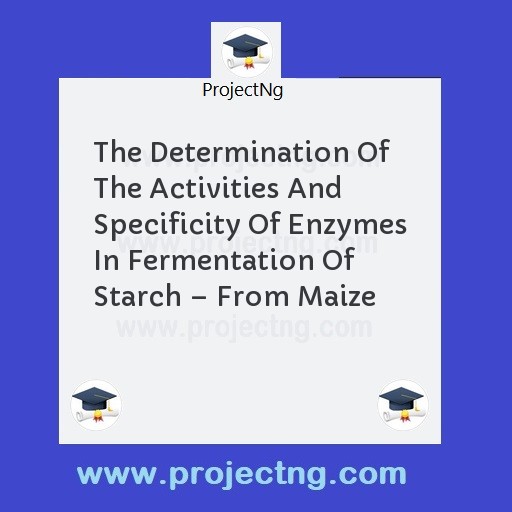The Determination Of The Activities And Specificity Of Enzymes In Fermentation Of Starch – From Maize
Science Lab Technology Project Topics
Get the Complete Project Materials Now! »
THE DETERMINATION OF THE ACTIVITIES AND SPECIFICITY OF ENZYMES IN FERMENTATION OF STARCH – FROM MAIZE
ABSTRACT
The Anatomy of this project write-up encompasses the ordinary look of enzymes as organic molecules, rather it sheds more light into the comprehensive view and determination of the catalytic and specific activity enzymes particularly- DIASTASE, MALTASE and ZYMASE can exploit in industrial application, also critically important is the selective ways of providing fundamental data which allows the society-particularly small-scale brewers to understand and exploit the chemistry of fermentation by enzymes. The method employed in this project involves three processes namely.
1. The preparation of the enzymes by fermentation
2. The preparation of the starch substrate from maize
3. The overall process development involving both the products of the 1st and 2nd processes. The results of the method and procedures employed in this project are. That enzyme activities in biochemical processes involves catalysis- through binding of the enzyme molecule and the substrates. Finally, all enzymes in fermentation of starch whose catalytic properties rely on their molecular structure and arrangement are stabilized by interactions between their constituents. This is conclusively evident in the chemistry of the fermentation process in starch which is later discussed and highlighted in this write-up.
TABLE OF CONTENTS
Title page
Certification
Dedication
Acknowledgement
Abstract
CHAPTER ONE
Background Information
Aim of the Study
Objectives of the Study
Significance of the Study
Statement of Problem
CHAPTER TWO
Literature Review
Chemistry of Fermentation
The Role of the Enzymes
CHAPTER THREE
Materials and Methodology
Materials and equipments
Methodology and procedures
The Process Development
Preparation of the Enzymes by Fermentation
Preparation of the Starch Substrate from Maize
Flowchart representing the Overall Process Development
CHAPTER FOUR
Results
Conclusion
CHAPTER FIVE
Recommendation
REFERENCES
CHAPTER ONE
1.0 INTRODUCTION
1.1 BACKGROUND INFORMATION
The primary aim of this project is center on the determination of the catalytic and specific activities of enzymes in fermentation of starch from maize.
These enzymes are DIATASE, MALTASE and ZYMASE.
This determination study is made possible through certain unique properties which these collection of enzymes possess.
Speaking in concrete terms, ENZYMES serve as bio-catalysts, speeding up chemical reactions, like those involved with fermentation of starch. Enzyme molecules accelerate the rate of reactions, often by many orders of magnitude, thereby allowing the substance involved undergo a chemical breakdown.
Enzymes in fermentation of starch go about their work in an ASSEMBLY-LINE fashion; each enzyme performing a specific task at a particular stage of the fermentation process. For instance, the enzyme-MALTASE, breaks down MALTASE into two isomeric fermentable sugars namely Glucose and Fructose; thereby preparing another stage for another enzyme to act during the fermentation process. Enzymes in fermentation process especially in starch; perform their work at blinding speed.
A single molecule of enzyme can catalyze thousand of chemical reactions per second. This is because enzymes in fermentation reaction particularly in starch; have a marked ability to accelerate the reaction and also to promote the specific processes involved under the chemically mild conditions which prevails in the fermentation process.
In all ways, these enzymes readily make essentials physiochemical contributions to the fermentation process by virtue of their organized and involved three dimensional structure which reveals certain regions on the enzyme surface where small solute molecules or ions can bind reversibly. Such solutes are called LIGANDS; a farm borrowed from ORGANOMETALIC CHEMISTRY.
There may be many ligard binding sites on the surface of an enzyme, but each site usually possesses the power to bind only a limited range of ligards, by virtue of the character of the site. The term “CHARACTER” is there used to cover not only the three-dimensional shape of the site but also its charge characteristics and to what degree if is hydrophobic or hydrophilic.
Be the First to Share On Social

Enjoying our content?
Don't miss out on new videos! Subscribe to our YouTube channel for more awesome content.
Subscribe Now!













